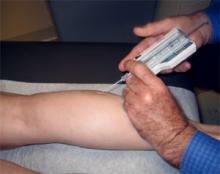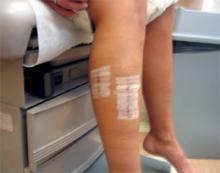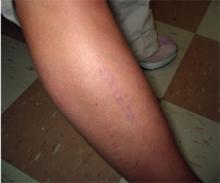MIBI scintigraphy has shown decreased muscle perfusion at peak exercise when compared with next-day imaging.16,17
Laser Doppler flow studies conducted in the post-exercise period have demonstrated a delayed peak hyperemia in CCS patients, different from the gradual decrease in blood flow seen in controls.18
Finally, multiple studies have been conducted done with magnetic resonance imaging. Comparisons of pre- and postexercise imaging have shown a greater increase in signal intensity in patients with CCS.19 Despite these findings, though, no clear clinical indications for these tools exist.
FIGURE 2
Measurement with Stryker stic
Measurement of lateral superficial posterior compartment pressure with the Stryker stic on a 16-year-old girl with 4-month history of exertional calf pain.
Treatment options
Conservative measures unconvincing
A few studies have addressed the efficacy of conservative treatment of CCS, but most physicians have found such therapy unsuccessful. Modalities tried include nonsteroidal anti-inflammatory drugs (NSAIDs), diuretics, compression, stretching, orthoses, massage, prolonged rest, change in training surface, change in footwear, change in sport, heat, electrostimulation, and whirlpool.20
One small study showed that compartment pressures in middle-aged men with CCS decreased following treatment with diuretics.21 Another small study showed that athletes receiving compartmental massage increased the duration of time they were able to exercise before developing symptoms.22 A third trial found competitive runners to have significantly higher pressures than competitive cyclists, suggesting runners with CCS may be able to bike as an alternative form of exercise.23
The few data regarding other modalities suggests that only prolonged rest or cessation of sport is effective.24,25 These options, however, may be impractical for competitive athletes who often have no desire to modify their sports participation. With little available evidence, the decision to offer conservative treatment and the type of conservative therapy to recommend remain controversial.
Fasciotomy track record good
Fasciotomy is the most widely used surgical treatment for CCS. The surgeon makes 1 to 3 small skin incisions, exposes the underlying fascia of the affected compartment, and incises the fascia (FIGURES 3 AND 4). Most of these operations are performed under local anesthesia and last less than an hour. Complications are rare, but can include seroma, hemorrhage, cellulitis, peripheral nerve injury, popliteal injury, tibial artery injury, and deep vein thrombosis (DVT).1,2
Patient satisfaction with the operation ranges from 80% to 95% in most published series.1,2,3,5,26 The typical postoperative course involves crutches for the first few days, followed by nonimpact aerobic training for 2 to 4 weeks. Impact aerobic training is next, with gradual return to sport by 2 to 3 months depending on the intensity of sports participation and type of sport practiced.1,4
Faciectomy preferred by some. Though published long-term follow-up data are few, Turnipseed et al found an 11% CCS recurrence rate among patients undergoing fasciotomies before 1985, compared with a 6% recurrence among patients who received fasciectomies between 1991 and 2001.1 The latter procedure involves excision of strips of fascia, which theoretically should decrease the risk of scarring over the compartment and subsequent recurrence of symptoms. This is one reason fasciectomy has become the procedure of choice for some physicians, while others reserved it for patients with recurrent CCS. Until a randomized study is performed, it will be difficult to compare the efficacy of fasciotomy and faciectomy.
FIGURE 3
5 days postsurgery
21-year-old female collegiate track athlete 5 days after anterior, lateral, and lateral superficial posterior compartment release.
FIGURE 4
6 months later
16-year-old female hockey and soccer player 6 months after anterior and lateral fasciectomy.
Acknowledgments
The author would like to thank Dr. William Turnipseed, MD, Department of Vascular Surgery, University of Wisconsin, for his assistance in the preparation of this review article.
CORRESPONDING AUTHOR
Jon Englund, MD, Memorial Healthplex Sports Medicine Institute, 111 West Jefferson, South Bend, IN 46601. E-mail: jon.englund@aurora.org




